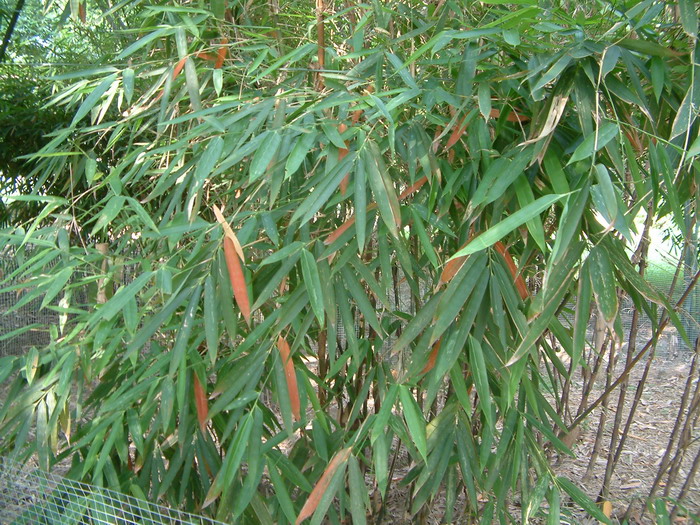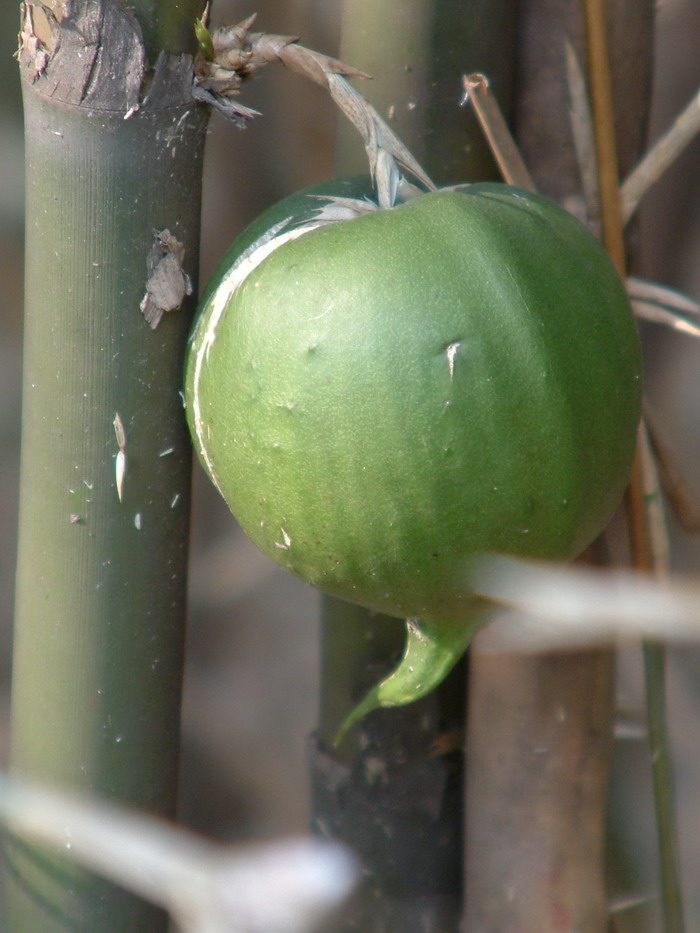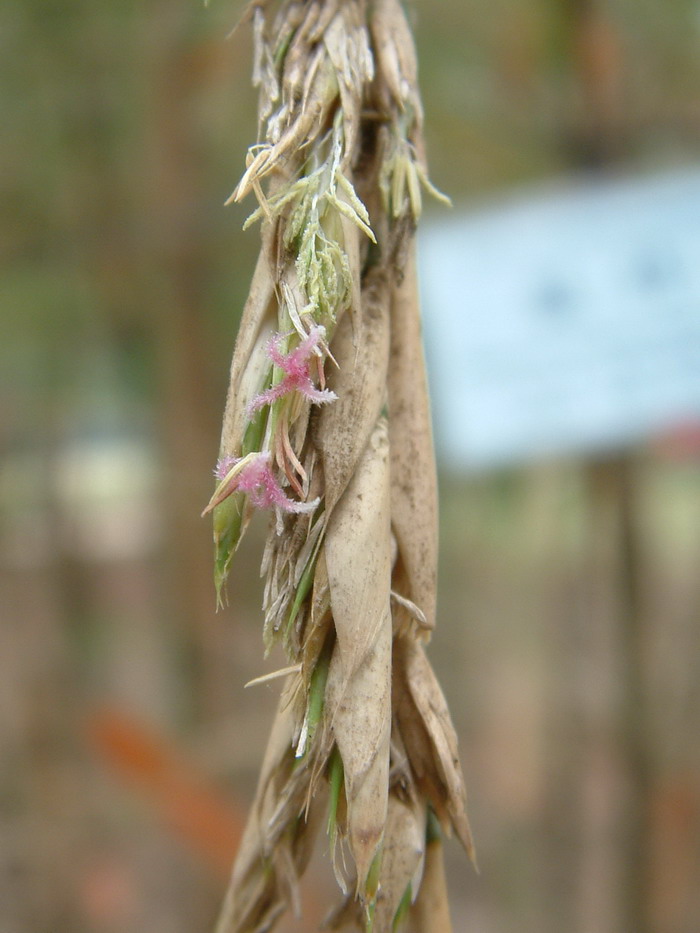小梨竹 Melocanna humilis
中文名(Chinese Name):小梨竹
学名(Scientific Name):Melocanna humilis Roep. ex Trin.
英文名(English Common Name):
别名(Chinese Common Name):
异名(Synonym):Melocanna arundina C. E. Parkinson
科属(Family & Genus):禾本科(Gramineae)梨竹属
形态特征(Description):
分布(Distribution):原产印度、孟加拉及巴西斯坦等地。
用途(Use):
引自中国植物志英文版FOC Vol. 22 Page 56
Melocanna humilis Kurz, J. Asiat. Soc. Bengal, Pt. 2, Nat. Hist. 42: 251. 1873.
梨竹 li zhu | Poaceae | Melocanna
Melocanna arundina C. E. Parkinson, nom. illeg. superfl.
Rhizome terete, to 5 m long, ca. 2.5 cm in diam., solid. Culms upright, with nodding tip, 8–20 m, 3–7 cm in diam.; internodes green initially, straw-colored when old, terete, (12–) 20–50 cm, slightly white powdery and pubescent initially, glabrous when old; wall 5–7.5 mm thick; nodal ridge not prominent; sheath scar evident. Branches many at upper nodes. Culm sheaths initially yellow-green, 10–15 cm, apex broadly concave, rigid, leathery, with deciduous, appressed, stiff, short, white hairs; uppermost part inflated; auricles inconspicuous; oral setae well developed; ligule short, serrulate at margin; blade erect, linear-triangular, 10–30 cm, base ca. 2.5 cm wide. Leaf sheaths glabrous; auricles tiny, usually absent; oral setae 8–10 per side, deciduous, white, undulate or curved, 8–15 mm; blade lanceolate to oblong-lanceolate, 15–24(–35) × 2.5–3.5 cm. Pseudospikelets in clusters of 3 or 4 in axils of bracts, ca. 1.3 cm, glabrous; bracts 2–4, lanceolate. Lemma ovate-lanceolate; palea convolute, not keeled; lodicules 2. Ovary globose, glabrous; style slender; stigmas 2–4, outcurved. Fruit pear-shaped, large, 4.5–12.5 × 5–7 cm, fleshy, apex with a long, curved beak.
Cultivated. Guangdong, Guangxi, Taiwan [native to Myanmar].
The only difference from Melocanna baccifera Kurz is apparently stature: M. baccifera is larger than M. humilis, although internode length and leaf sheath auricles also require comparison. Melocanna humilis was misidentified in FRPS (9(1): 13. 1996) as M. baccifera, for which name M. bambusoides is a widely used synonym. Melocanna baccifera is also in cultivation in Guangzhou.
The culms are used for pulping and are split for weaving, the leaves are used for making wine, and the fruit is edible.


 (责任编辑:徐晔春)
(责任编辑:徐晔春)
学名(Scientific Name):Melocanna humilis Roep. ex Trin.
英文名(English Common Name):
别名(Chinese Common Name):
异名(Synonym):Melocanna arundina C. E. Parkinson
科属(Family & Genus):禾本科(Gramineae)梨竹属
形态特征(Description):
分布(Distribution):原产印度、孟加拉及巴西斯坦等地。
用途(Use):
引自中国植物志英文版FOC Vol. 22 Page 56
Melocanna humilis Kurz, J. Asiat. Soc. Bengal, Pt. 2, Nat. Hist. 42: 251. 1873.
梨竹 li zhu | Poaceae | Melocanna
Melocanna arundina C. E. Parkinson, nom. illeg. superfl.
Rhizome terete, to 5 m long, ca. 2.5 cm in diam., solid. Culms upright, with nodding tip, 8–20 m, 3–7 cm in diam.; internodes green initially, straw-colored when old, terete, (12–) 20–50 cm, slightly white powdery and pubescent initially, glabrous when old; wall 5–7.5 mm thick; nodal ridge not prominent; sheath scar evident. Branches many at upper nodes. Culm sheaths initially yellow-green, 10–15 cm, apex broadly concave, rigid, leathery, with deciduous, appressed, stiff, short, white hairs; uppermost part inflated; auricles inconspicuous; oral setae well developed; ligule short, serrulate at margin; blade erect, linear-triangular, 10–30 cm, base ca. 2.5 cm wide. Leaf sheaths glabrous; auricles tiny, usually absent; oral setae 8–10 per side, deciduous, white, undulate or curved, 8–15 mm; blade lanceolate to oblong-lanceolate, 15–24(–35) × 2.5–3.5 cm. Pseudospikelets in clusters of 3 or 4 in axils of bracts, ca. 1.3 cm, glabrous; bracts 2–4, lanceolate. Lemma ovate-lanceolate; palea convolute, not keeled; lodicules 2. Ovary globose, glabrous; style slender; stigmas 2–4, outcurved. Fruit pear-shaped, large, 4.5–12.5 × 5–7 cm, fleshy, apex with a long, curved beak.
Cultivated. Guangdong, Guangxi, Taiwan [native to Myanmar].
The only difference from Melocanna baccifera Kurz is apparently stature: M. baccifera is larger than M. humilis, although internode length and leaf sheath auricles also require comparison. Melocanna humilis was misidentified in FRPS (9(1): 13. 1996) as M. baccifera, for which name M. bambusoides is a widely used synonym. Melocanna baccifera is also in cultivation in Guangzhou.
The culms are used for pulping and are split for weaving, the leaves are used for making wine, and the fruit is edible.
踩一下[0]

顶一下[1]